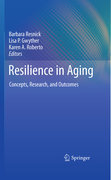
Resilience in aging: concepts, research, and outcomes
Resnick, Barbara
Gwyther, Lisa P.
Roberto, Karen A.
The many significant technological and medical advances of the 21 st century cannot overcome the escalating risk posed to older adults by such stressors aspain, weakness, fatigue, depression, anxiety, memory and other cognitive deficits, hearing loss, visual impairment, isolation, marginalization, and physical and mental illness. In order to overcome these and other challenges, and to maintain as high a quality of life as possible, older adults and the professionals who treat them need to promote and develop the capacity for resilience, which is innate in all of us to some degree. The purpose of this book is to provide the current scientific theory, clinical guidelines, and real-world interventions with regard to resilience as a clinical tool. To that end, the book addresses such issues as concepts and operationalization of resilience; relevance of resilience to successful aging; impact of personality and genetics on resilience; relationship between resilience and motivation; relationship between resilience and survival; promoting resilience in long-term care; and the lifespan approach to resilience. By addressing ways in which the hypothetical and theoretical concepts of resilience can be applied in geriatric practice, Resilience in Aging provides inroads to the current knowledge and practice of resilience from the perspectives of physiology, psychology, culture, creativity, andeconomics. In addition, the book considers the impact of resilience on critical aspects of life for older adults such as policy issues (e.g., nursing home policies, Medicare guidelines), health and wellness, motivation, spirituality,and survival. Following these discussions, the book focuses on interventions that increase resilience. The intervention chapters include case studies and are intended to be useful at the clinical level. The book concludes with a discussion of future directions in optimizing resilience in the elderly and the importance of a lifespan approach to aging. " This is the only book to focus exclusively on resilience and the aging process Editor was the recipient of the Gerontological Society of America’s (GSA’s) 2008 Doris Schwartz Gerontological Nursing Research Award The theme of the 2008 conference was 'Resilience in an Aging Society: Risks and Opportunities' INDICE: Section 1. Introduction .- Definition and Concepts of Resilience.-Relevance of Resilience to Successful Aging.- Section 2. Principles and Concepts of Resilience .- Resilience and the Impact of Personality and Genetics.- Resilience in Older Adults.- Psychological Resilience.- Physiological Resilience and the Impact on Health.- Creative Resilience.- Economic Resilience.- Resilience from a Cultural Perspective.- Section 3. Special Considerations of Resilience with Respect to Health, Behavior, Beliefs, and Policy .- Resilience in Aging and the Interplay with Policy.- Religion, Spirituality, and Resilience.- Resilience in Chronic Disease.- Relationship Between Resilience and Motivation.- Relationship Between Resilience and Survival.- Se ction 4. Interventions toIncrease Resilience .- Fostering Resilience Through Narratives.- Building Resilience in Mild Cognitive Impairment.- Use of Relation to Strengthen Resilience.- Environmental Interventions to Strengthen Resilience.- Supporting Resilience in Long-Term Care.- Promoting Resilience Through Interdisciplinary Interventions.- Section 5. Future Directions .- Optimizing Resilience in the Twenty-first Century.- The Lifespan Approach to Resilience.- Conclusion.
- ISBN: 978-1-4419-0231-3
- Editorial: Springer
- Encuadernacion: Cartoné
- Páginas: 380
- Fecha Publicación: 29/10/2010
- Nº Volúmenes: 1
- Idioma: Inglés
